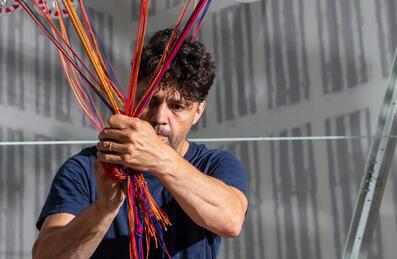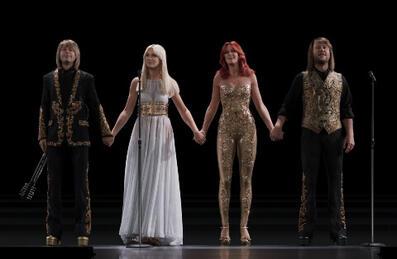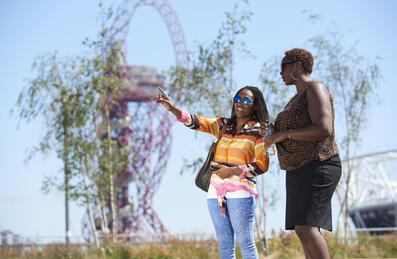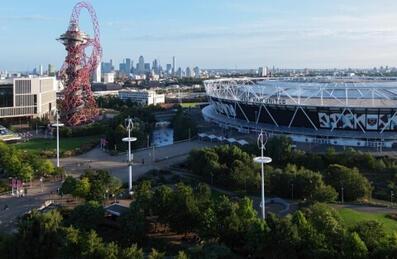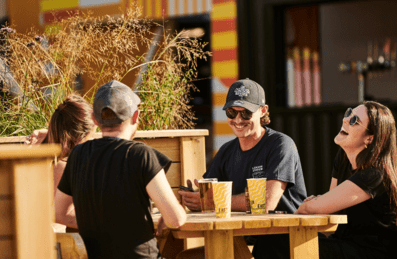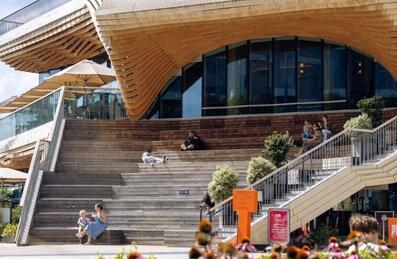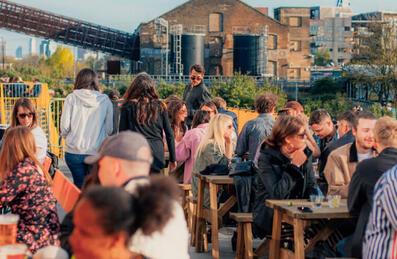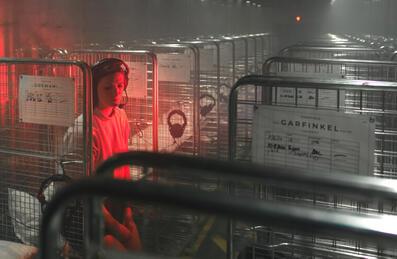
Popular Searches:
Keep up to date
Sign up today for exclusive offers and incredible experiences you won’t want to miss at Queen Elizabeth Olympic Park.
Sign up nowRIDE THE SLIDE AT THE ARCELORMITTAL ORBIT
RIDE THE SLIDE AT THE ARCELORMITTAL ORBIT
Press Release 26/06/2016
A brand new hair-raising experience! Riders will experience the twists, turns and drops of the world’s longest and tallest tunnel slide as it weaves its way through Anish Kapoor’s iconic red sculpture.
- The world’s longest and tallest tunnel slide opens on 24 June
- Experience 12 twists and turns at speeds of up to 15mph
- Designed by Belgian artist Carsten Holler, at the invitation of Anish Kapoor, the creator of the ArcelorMittal Orbit
- #RideTheSlide
- Visit www.arcelormittalorbit.com to book your ride - click here to see the video!
From Friday 24 June, visitors to Queen Elizabeth Olympic Park are being challenged to ‘Ride the Slide’, a brand new hair-raising experience at the ArcelorMittal Orbit. Riders will experience the twists, turns and drops of the world’s longest and tallest tunnel slide as it weaves its way through Anish Kapoor’s iconic red sculpture.
Visitors can enjoy breath-taking views of up to 20 miles across London from the ArcelorMittal Orbit’s two viewing galleries before experiencing an exhilarating 40 second descent in the 178m long slide. Riders will travel through light and dark sections at speeds of up to 15mph as the slide loops its way around the sculpture 12 times taking in gentle curves, thrilling drops and a tight corkscrew named ‘the bettfeder’ – bedspring in German.
The Slide is not just an exhilarating new experience, it is also a major new art installation. Created by Belgian artist Carsten Höller at the invitation of the ArcelorMittal Orbit’s designer, Anish Kapoor, the slide is a unique collaboration between two of the world’s most renowned contemporary artists. The intricate twisting metal slide is made up of 30 sections of ArcelorMittal
steel, each measuring between five and seven metres long. A specialist team of abseilers spent nine weeks installing the individual pieces using ropes and pulleys.
Anish Kapoor, said, "I am delighted that my work, the ArcelorMittal Orbit at Queen Elizabeth Olympic Park is the site for a collaboration with Carsten Höller. I believe it will result in the making of a new work which will bring two works of art together in an ambitious way.”
Carsten Höller, said: “Since 1999, I have built a number of slides, both free-standing and attached to buildings, but never onto another artwork as in this case. Now that the two artworks will be intertwined with each other, I see it as one of these double situations that I am so interested in. I like it when a sense of unity is reached in two separate entities, and you can find this thought to repeatedly occur in my work.”
Lakshmi Mittal, Chairman and CEO of ArcelorMittal said: “I am delighted to continue to support the ArcelorMittal Orbit through the supply of the steel necessary to build the slide. I can’t wait to have a go! I am sure that the addition of the slide will attract new and repeat visitors, cementing the ArcelorMittal Orbit’s role as not just a great work of art and a great experience, but also as a symbol for the regeneration of East London.”
Peter Tudor, Director of Visitor Services at Queen Elizabeth Olympic Park, said: “We are so thrilled to welcome the first riders to The Slide, which really is an extraordinary addition to Anish Kapoor’s iconic sculpture. It is a whole new sensory experience for visitors as they whizz through light and dark sections and view the ArcelorMittal Orbit like never before. Together with spectacular views it is another great reason to visit Queen Elizabeth Olympic Park this summer.”
Construction was led by Buckingham Group Constructing Ltd using specialist abseilers provided by CAN Structures, with structural engineering work provided by BuroHappold. The Slide has been manufactured by world-renowned slide manufacturer Wiegand and British firm Interkey, who are based in Corby. Steel has been generously contributed by ArcelorMittal, whose original donation made possible the realisation of Anish Kapoor and Cecil Balmond’s vision for the ArcelorMittal Orbit in 2012.
Fact Box
• The Slide is the world's tallest and longest tunnel slide at 178m long and 76m high
• It twists and turns 12 times, including a tight corkscrew section named the ‘bettfeder’ – after the German word for ‘bedspring’
• The Slide ends with a 50 metre straight run to the ground
• In the exhilarating 40-second trip, riders are expected to hit speeds of up to 15 miles per hour
• The Slide is made from 800mm diameter, 3mm thick stainless steel tubes that make up 30 sections
• People will be able to see out through polycarbonate 'windows' for some of The Slide
• Riders will slide on a specially designed mat
• The Slide was designed by Belgian artist Carsten Holler, at the invitation of Anish Kapoor, the creator of the ArcelorMittal Orbit
• Combined ticket prices for the ArcelorMittal Orbit and The Slide are £15 for an adult, £10 for children and £46 for a family of four when booked in advance
For high resolution images visit http://www.2012imagelibrary.co.uk/library/token/631/4f0f3ea6c0d8f7f275b…
For more information contact the Press Office at Queen Elizabeth Olympic Park on +44 (0) 20 3734 9010 or email press@QueenElizabethOlympicPark.co.uk
London’s newest visitor destination, Queen Elizabeth Olympic Park, is a place unlike any other. Visitors to the Park are able to enjoy beautiful parklands and waterways, world-famous sporting venues, arts and events and spectacular views from the ArcelorMittal Orbit. As a new heart for east London, the Park will also provide new homes, jobs and a cultural and education quarter.
The London Legacy Development Corporation promotes and delivers physical, social, economic and environmental regeneration in Queen Elizabeth Olympic Park and the surrounding area, in particular by maximising the legacy of the London 2012 Olympic and Paralympic Games.
For more information visit QueenElizabethOlympicPark.co.uk, follow us on Twitter @noordinarypark and like us on Facebook facebook.com/QueenElizabethOlympicPark
The ArcelorMittal Orbit originated in 2009 when former London Mayor Boris Johnson launched a competition to design a sculpture for the Olympic Park. Sir Anish Kapoor and Cecil Balmond’s design of a continually looping red steel tower won the competition. Its construction was made possible by Lakshmi Mittal who provided sponsorship and all of the 2000 tonnes of steel used. Further funding was provided by the former Mayor of London’s office and the London Development Agency. The viewing galleries are accessed by two high speed lifts and provide stunning panoramic views across 20 miles of London. Innovative screens allow visitors to learn about key sights across the capital from The Shard and St Paul’s to Canary Wharf and the world-famous sporting venues of Queen Elizabeth Olympic Park. There’s also two incredible mirrors created by one of the sculpture’s creators Sir Anish Kapoor which flip and twist the horizon. After leisurely taking in the views, visitors are encouraged to walk down the 455 steps which spiral around the central column so they fully experience the constantly changing perspectives from every angle. The ArcelorMittal Orbit has full wheelchair access. For more information visit www.arcelormittalorbit.com
Ticket Prices
ArcelorMittal Orbit and The Slide combined ticket prices (ArcelorMittal Orbit prices only)
Walk up In Advance Local Resident Annual Pass
Adult £17 (£12) £15 (£10) £15 (£10) (£15 for the AMO only)
Child £12 (£7) £10 (£5) £10 (£5) (£8 for the AMO only)
Senior/Student £15 (£10) £12 (£7) £13 (£8) (£13 for the AMO only)
Family of Four £52 (£32) £46 (£26) N/A
• There are no Annual Passes for the Slide; if you are an annual pass holder, you only pay the £5 for the Slide.
• Tickets will be issued in 15 minute timeslots, with up to 20 tickets allocated per slot. If a visitor misses or is late for their timeslot we will try to accommodate them at the next available point. There will only be one person allowed on a mat at any one time.
• Each ticket is valid for one use of the Slide. Visitors must follow the instruction of staff at all times. We reserve the right to refuse entry to the Slide for operational or health and safety reasons.
Visitors using the Slide must...
• be at least 1.3m in height and eight years old or over to use the slide
• weigh under 149kg (23.7stone)
• seek medical advice if they have any pre-existing medical conditions
• be in the queue at the entrance to the Slide on the upper platform at the time stated on their ticket
• slide feet first
• only slide with the use of a mat
• not slide under the influence of alcohol or drugs
• keep arms and elbows close to the body whilst sliding and hold the safety cord of the mat at all times
• not wear loose clothing, large jewellery or inappropriate footwear on the slide
• not slide with bags or other large belongings (e.g. umbrellas)
• not use the slide without staff supervision
• not slide on their stomach
• not attempt break or stop during their journey down the Slide
• leave the Slide immediately when they reach the end of the Slide
• The use of go-pros and other electronic devices on the Slide are not permitted
• If you have a heart condition, back or neck injuries, claustrophobia, vertigo, if you are pregnant or if you have any condition that prevents you from following all of the safety rules and guidelines, you may not ride the slide
• All materials used to enhance speed are strictly prohibited.
Slide Accessibility
We will do our best to accommodate visitor needs. Visitors who are disabled or who require adaptations to accommodate any additional needs are asked to contact our team on 03338008 099 prior to booking.
The Operations team will aim to accommodate as wide a range of physical ability on a regular day of operation as possible, however we will run regular access sessions.
For these sessions visitors can book a session where there will be additional staff on hand to support visitors and there will be fewer visitors booked in per session to allow additional time for each visitor.
Carsten Holler and Anish Kapoor: Biographies
Carsten Höller uses his training as a scientist in his work as an artist, concentrating particularly on the nature of human relationships. Born in Brussels in 1961, he now lives and works in Stockholm. His major installations include Test Site, a series of giant slides for Tate Modern’s Turbine Hall (2006), Amusement Park - an installation of full-size funfair rides turning and moving at very slow speed at MASS MoCA, North Adams, USA (2006), Flying Machine (1996), a work which hoists the viewer through the air, Upside-Down Goggles, an experiment with goggles which modify vision, The Double Club (2008-2009) in London, which opened in November 2008 and closed in July 2009, took the form of a bar, restaurant and nightclub designed to create a dialogue between Congolese and Western culture. His Revolving Hotel Room, 2008, a rotating art installation which becomes a fully operational hotel room at night, was shown as part of theanyspacewhatever exhibition at the Guggenheim Museum in 2009. His works have been shown internationally over the last two decades, including solo exhibitions at Fondazione Prada, Milan (2000), the ICA Boston (2003), Musée d'Art Contemporain, Marseille (2004), Kunsthaus Bregenz, Austria (2008), Museum Boijmans Van Beuningen, Rotterdam (2010), Hamburger Bahnhof, Museum für Gegenwart, Berlin (2011), New Museum, New York (2011) and TBA 21, Vienna (2014).
Anish Kapoor is one of the most important contemporary artists working today. Perhaps most famous for public sculptures that are both adventures in form and feats of engineering, he manoeuvres between vastly different scales, across numerous series of work. Immense PVC skins, stretched or deflated; concave or convex mirrors whose reflections attract and swallow the viewer; recesses carved in stone and pigmented so as to disappear: these voids and protrusions summon up deep-felt metaphysical polarities of presence and absence, concealment and revelation. Forms turn themselves inside out, womb-like, and materials are not painted but impregnated with colour, as if to negate the idea of an outer surface, inviting the viewer to the inner reaches of the imagination. Kapoor’s geometric forms from the early 1980s, for example, rise up from the floor and appear to be made of pure pigment, while the viscous, blood-red wax sculptures from the last ten years – kinetic and self-generating – ravage their own surfaces and explode the quiet of the gallery environment. There are resonances with mythologies of the ancient world – Indian, Egyptian, Greek and Roman – and with modern times, where twentieth century events loom large.
Anish Kapoor was born in Bombay, India in 1954 and lives and works in London. He studied at Hornsey College of Art (1973–77) followed by postgraduate studies at Chelsea School of Art, London (1977–78). Recent major solo exhibitions include Château de Versailles (2015); Sakıp Sabancı Museum, Istanbul (2013); Martin Gropius Bau, Berlin (2013); Museum of Contemporary Art, Sydney (2012); Le Grand Palais, Paris (2011); Mehboob Studios, Mumbai and National Gallery of Modern Art, New Delhi (2010); Royal Academy of Arts (2009) and the Turbine Hall, Tate Modern, London (2002). He represented Britain at the 44th Venice Biennale (1990), for which he was awarded the Premio Duemila. He won the Turner Prize in 1991 and has honorary fellowships from the London Institute and Leeds University (1997), the University of Wolverhampton (1999) and the Royal Institute of British Architecture (2001). He was awarded a CBE in 2003 and a Knighthood in 2013 for services to visual arts.
